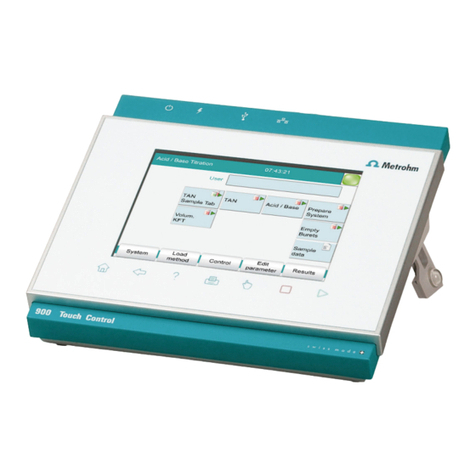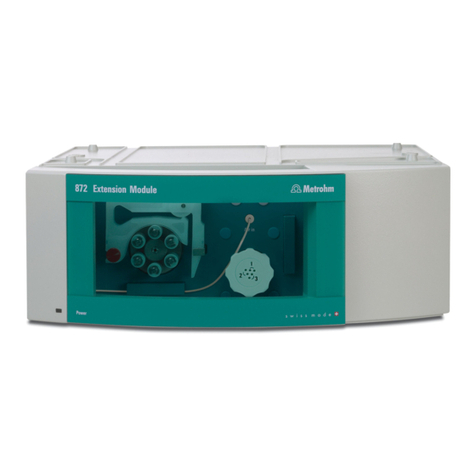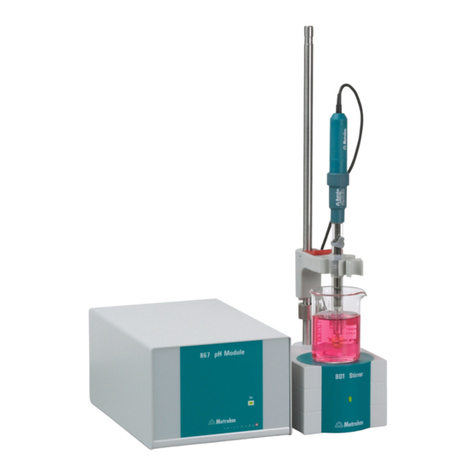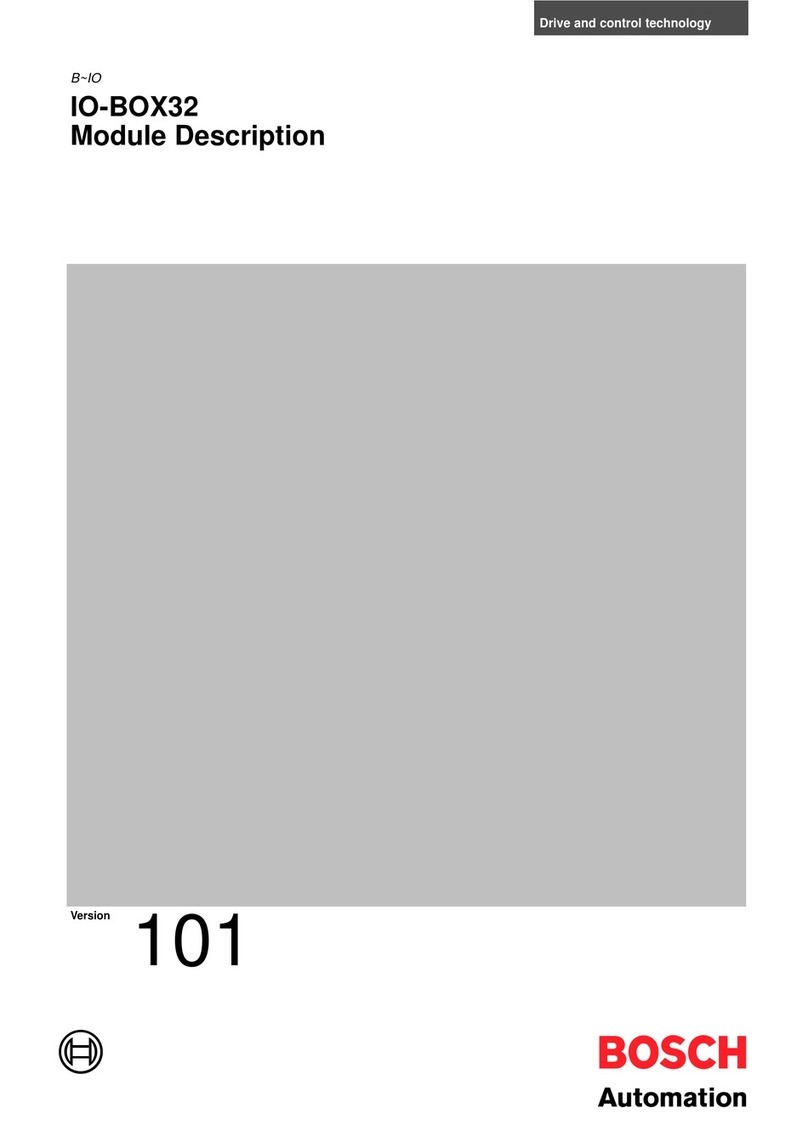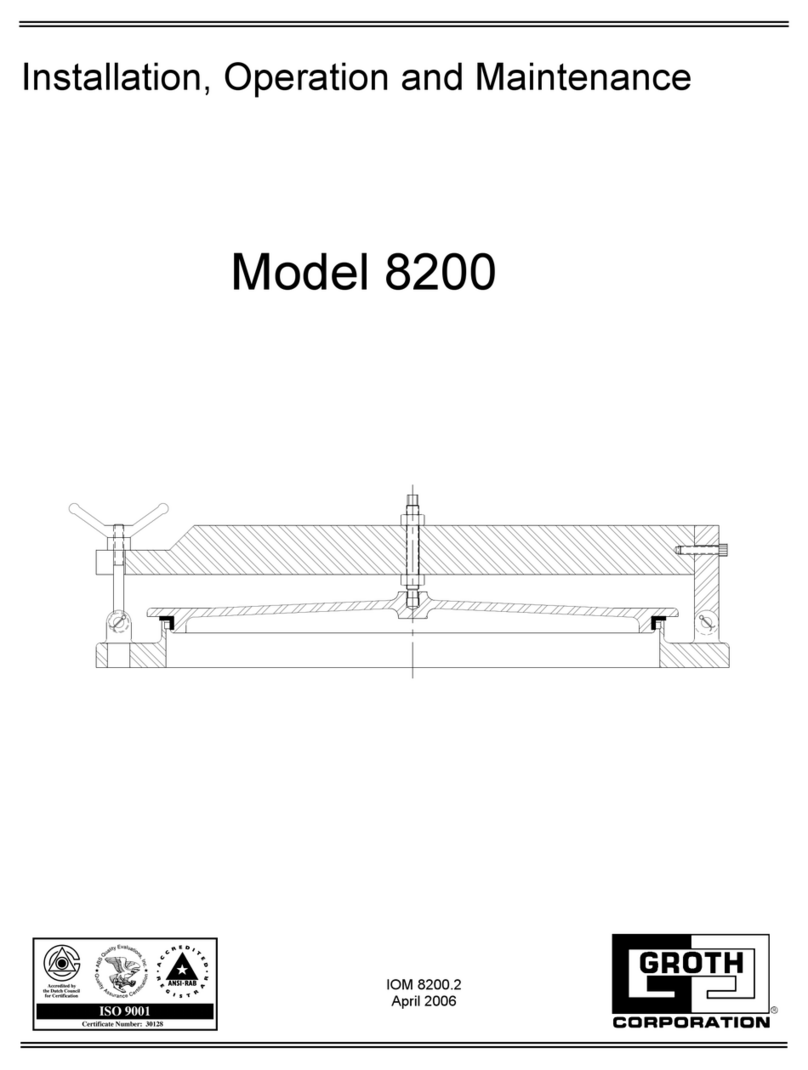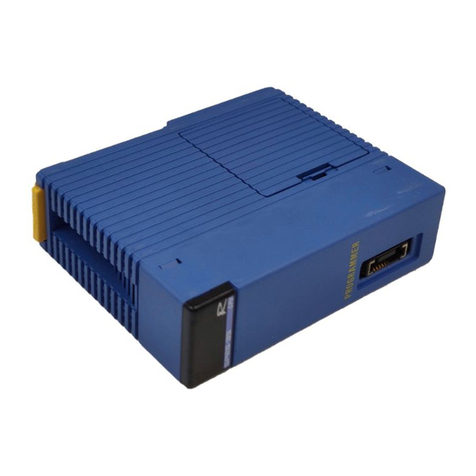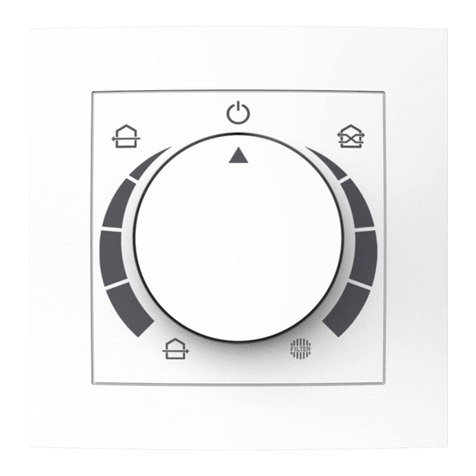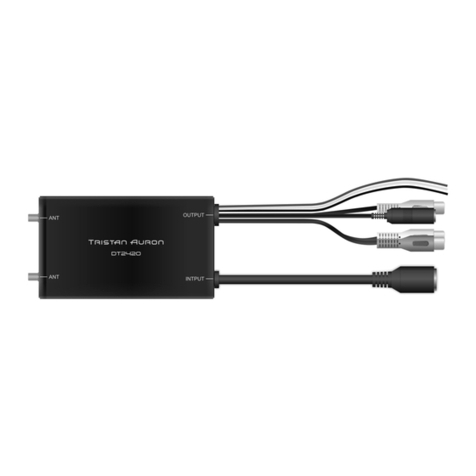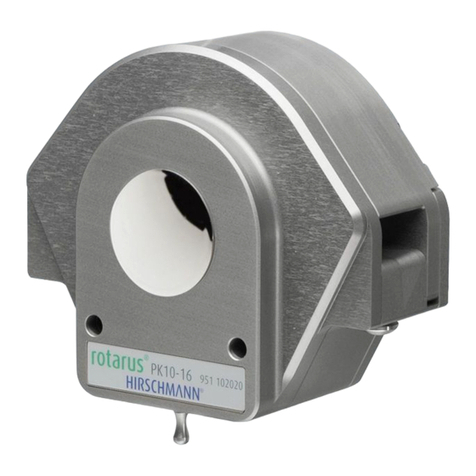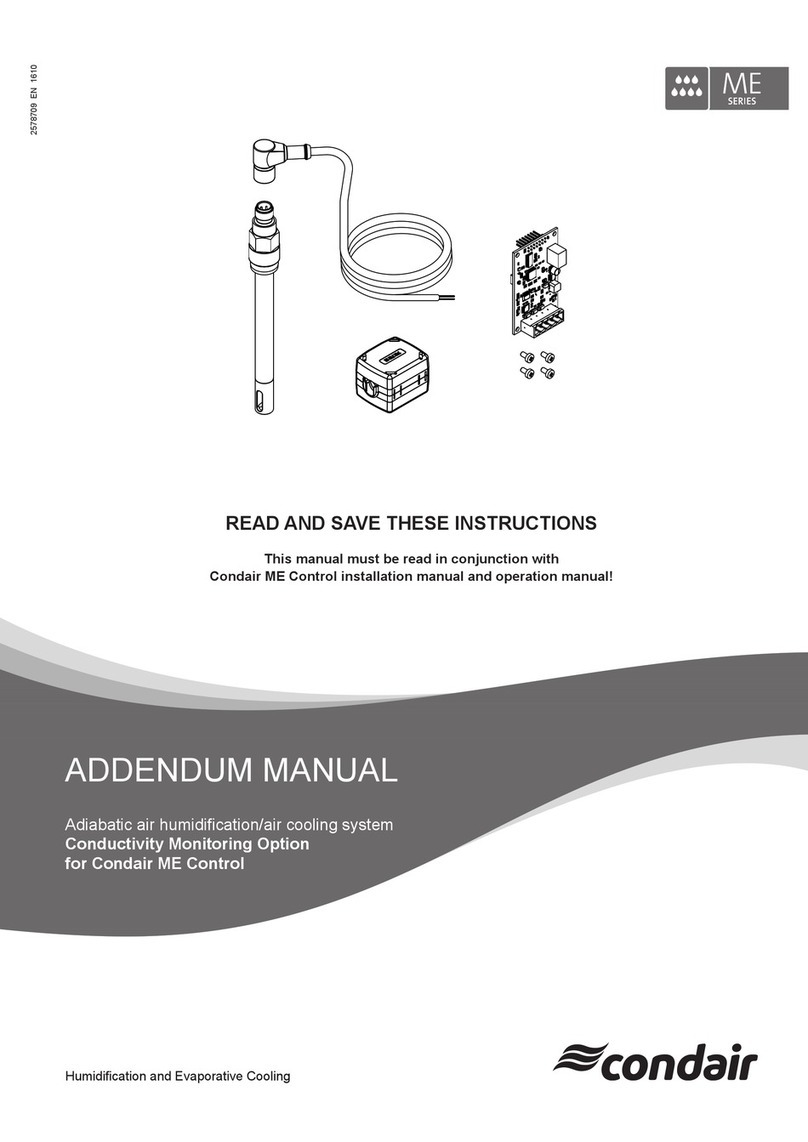Metrohm 872 User manual

872 Extension Modul
Sample Prep – 2.872.0050
Manual
8.872.8002EN


Metrohm AG
CH-9101 Herisau
Switzerland
Phone +41 71 353 85 85
Fax +41 71 353 89 01
www.metrohm.com
872 Extension Modul
Sample Prep – 2.872.0050
Manual
8.872.8002EN 03.2008 zst

Teachware
Metrohm AG
CH-9101 Herisau
This documentation is protected by copyright. All rights reserved.
Although all the information given in this documentation has been
checked with great care, errors cannot be entirely excluded. Should you
notice any mistakes please send us your comments using the address
given above.
Documentation in additional languages can be found on
http://products.metrohm.com under Literature/Technical documenta-
tion.

■■■■■■■■■■■■■■■■■■■■■■ Table of contents
872 Extension Modul – Sample Prep ■■■■■■■■ III
Table of contents
1Introduction 1
1.1 Instrument description ......................................................... 1
1.2 About the documentation ................................................... 2
1.2.1 Content and scope .................................................................. 2
1.2.2 Symbols and conventions ........................................................ 2
1.3 Safety instructions ................................................................ 3
1.3.1 General notes on safety ........................................................... 3
1.3.2 Electrical safety ........................................................................ 3
1.3.3 Working with liquids ................................................................ 4
1.3.4 Recycling and disposal ............................................................. 4
2Overview of the instrument 5
2.1 Front ...................................................................................... 5
2.2 Rear ........................................................................................ 5
3Installation 6
3.1 About this chapter ................................................................ 6
3.2 Extension Module and 850 Professional IC instru-
ment ....................................................................................... 6
3.3 Installation overview ............................................................ 7
3.4 Installation diagram ............................................................ 8
3.5 Mounting the extension module ......................................... 9
3.5.1 Preparing IC instrument ........................................................... 9
3.5.2 Mounting the extension module under IC instrument .............. 9
3.5.3 Mounting the extension module on IC instrument ................. 11
3.6 Connecting the extension module .................................... 12
3.6.1 Connecting the extension module ......................................... 12
3.6.2 Restoring connections to the IC instrument ............................ 13
3.7 Peristaltic pump .................................................................. 13
3.7.1 Principle of the peristaltic pump ............................................. 13
3.7.2 Installing the peristaltic pump ................................................ 14
3.8 Switching valve ................................................................... 18
3.8.1 Mode of operation of the switching valve .............................. 18
3.8.2 Connecting switching valve ................................................... 19
4Start-up 20
5Handling and maintenance 21
5.1 Door ..................................................................................... 21

Table of contents ■■■■■■■■■■■■■■■■■■■■■■
IV ■■■■■■■■ 872 Extension Modul – Sample Prep
5.2 Peristaltic pump .................................................................. 21
5.2.1 Operation .............................................................................. 21
5.2.2 Maintenance ......................................................................... 22
6Troubleshooting 24
6.1 Problems and their solutions ............................................. 24
7Technical specifications 25
7.1 Reference conditions .......................................................... 25
7.2 Instrument ........................................................................... 25
7.3 Ambient conditions ............................................................ 25
7.4 Housing ............................................................................... 26
7.5 Peristaltic pump .................................................................. 26
7.6 Switching valve ................................................................... 26
7.7 Interfaces ............................................................................. 27
7.8 Safety specification ............................................................ 27
7.9 Electromagnetic compatibility (EMC) ................................ 27
7.10 Weight ................................................................................. 27
8Conformity and warranty 28
8.1 Declaration of Conformity ................................................. 28
8.2 Quality Management Principles ........................................ 29
8.3 Warranty (guarantee) ......................................................... 30
9Accessories 31
9.1 Scope of delivery ................................................................ 31
9.2 Optional accessories ........................................................... 34
Index 36

■■■■■■■■■■■■■■■■■■■■■■ Table of figures
872 Extension Modul – Sample Prep ■■■■■■■■ V
Table of figures
Figure 1 Front of 872 Extension Modul – Sample Prep .................................... 5
Figure 2 Rear of 872 Extension Modul – Sample Prep ...................................... 5
Figure 3 Installation diagram – dialysis ............................................................ 8
Figure 4 Base tray from below ...................................................................... 10
Figure 5 Covering plate from above .............................................................. 11
Figure 6 Rear of the instrument .................................................................... 12
Figure 7 Peristaltic pump ............................................................................... 14
Figure 8 Installing the pump tubing .............................................................. 15
Figure 9 Install pump tubing with filter .......................................................... 16
Figure 10 Install pump tubing without filter .................................................... 16
Figure 11 Switching valve – connectors ........................................................... 19
Figure 12 Switching valve – valve positions ..................................................... 19
Figure 13 Pump tubing connection – changing the filter ................................. 23


■■■■■■■■■■■■■■■■■■■■■■ 1 Introduction
872 Extension Modul – Sample Prep ■■■■■■■■ 1
1 Introduction
1.1 Instrument description
Existing 850 Professional IC instruments can be expanded to include addi-
tional functions with extension modules. Every 850 Professional IC instru-
ment can be supplemented with up to 3 extension modules.
With the 872 Extension Modul – Sample Prep, an 850 Professional IC
instrument can be extended to include additional sample preparation pos-
sibilities. For example, this makes it possible also to have inline dialysis in
AnCat systems (2.850.30x0) or to prepare samples with an anion high
pressure gradient system (2.850.2220).
The extension module is operated with MagIC Net software, just like the
IC instrument. When it is connected to a 850 Professional IC instrument,
MagIC Net recognizes the extension module automatically and checks its
functional capability. It controls and monitors the IC instrument with
extension module, evaluates the measured data and administers it in a
database.
The 872 Extension Modul – Sample Prep comprises the following
components:
Peristaltic pump
Peristaltic pumps are used for pumping sample and auxiliary solutions.
They can rotate in both directions.
Switching valve
The switching valve corresponds in its design to the injection valve that is
utilized in the models of the 850 IC Professional series. It can however also
be utilized with sample preparation and then it acts as a switcher between
two different flows, e.g. in the sample dilution for switching between
sample dilution and direct injection.

1.2 About the documentation ■■■■■■■■■■■■■■■■■■■■■■
2■■■■■■■■ 872 Extension Modul – Sample Prep
1.2 About the documentation
1.2.1 Content and scope
This document describes the 872 Extension Modul – Sample Prep, its
assembly and connection to the IC instrument, as well as the installation,
operation and maintenance of the individual components. Technical data,
troubleshooting and information concerning scope of delivery and
optional accessories makes up the rest of the manual.
This document does not on the other hand describe the functions of the
IC instrument – extension module unit, nor does it describe the capillary
connections that proceed from the extension module. For this purpose,
please refer to the manual for the IC instrument and that for the sample
processor.
Additional information concerning the configuration of MagIC Net can be
found on the online help for MagIC Net.
1.2.2 Symbols and conventions
The following symbols and styles are used in this documentation:
Cross-reference to figure legend
The first number refers to the figure number, the
second to the instrument part in the figure.
Instruction step
Carry out these steps in the sequence shown.
Warning
This symbol draws attention to a possible life hazard
or risk of injury.
Warning
This symbol draws attention to a possible hazard due
to electrical current.
Warning
This symbol draws attention to a possible hazard due
to heat or hot instrument parts.
Warning
This symbol draws attention to a possible biological
hazard.

■■■■■■■■■■■■■■■■■■■■■■ 1 Introduction
872 Extension Modul – Sample Prep ■■■■■■■■ 3
Caution
This symbol draws attention to a possible damage of
instruments or instrument parts.
Note
This symbol marks additional information and tips.
1.3 Safety instructions
1.3.1 General notes on safety
Warning
This instrument may only be operated in accordance with the specifica-
tions in this documentation.
This instrument has left the factory in a flawless state in terms of technical
safety. To maintain this state and ensure non-hazardous operation of the
instrument, the following instructions must be observed carefully.
1.3.2 Electrical safety
The electrical safety when working with the instrument is ensured as part
of the international standard IEC 61010.
Warning
Only personnel qualified by Metrohm are authorized to carry out service
work on electronic components.
Warning
Never open the housing of the instrument. The instrument could be
damaged by this. There is also a risk of serious injury if live components
are touched.
There are no parts inside the housing which can be serviced or replaced
by the user.

1.3 Safety instructions ■■■■■■■■■■■■■■■■■■■■■■
4■■■■■■■■ 872 Extension Modul – Sample Prep
Mains voltage
Warning
An incorrect mains voltage can damage the instrument.
Only operate this instrument with a mains voltage specified for it (see
rear panel of the instrument).
Protection against electrostatic charges
Warning
Electronic components are sensitive to electrostatic charges and can be
destroyed by discharges.
Always pull the mains cable out of the mains connection socket before
connecting or disconnecting electrical appliances on the rear panel of
the instrument.
1.3.3 Working with liquids
Caution
Periodically check all system connections for leaks. Observe the relevant
regulations in respect to working with flammable and/or toxic fluids
and their disposal.
1.3.4 Recycling and disposal
This product is covered by European Directive 2002/96/EC, WEEE – Waste
from Electrical and Electronic Equipment.
The correct disposal of your old equipment will help to prevent negative
effects on the environment and public health.
More details about the disposal of your old equipment can be obtained
from your local authorities, from waste disposal companies or from your
local dealer.

■■■■■■■■■■■■■■■■■■■■■■ 2 Overview of the instrument
872 Extension Modul – Sample Prep ■■■■■■■■ 5
2 Overview of the instrument
2.1 Front
12
3
Figure 1 Front of 872 Extension Modul – Sample Prep
1Peristaltic pump 2Switching valve
3Standby indicator
2.2 Rear
In Out
Made by Metrohm Herisau Switzerland
12
Figure 2 Rear of 872 Extension Modul – Sample Prep
1Connector In
To connect the extension module to the IC
instrument or to a previous extension mod-
ule.
2Connector Out
To connect an additional extension module.

3.1 About this chapter ■■■■■■■■■■■■■■■■■■■■■■
6■■■■■■■■ 872 Extension Modul – Sample Prep
3 Installation
3.1 About this chapter
The Installation chapter contains
■this overview
■a general description of mounting and connection of IC instrument
and extension module.
■a brief set of instructions for the installation of the 872 Extension
Modul Sample Prep (see Chapter 3.3, page 7). At each step you will
find cross-references to more detailed installation instructions for indi-
vidual components, should you should require such aids.
■an installation diagram (see Chapter 3.4, page 8) which displays an
example for a possible installation.
■several chapters with extensive installation instructions for all compo-
nents.
3.2 Extension Module and 850 Professional IC instru-
ment
The extension modules are fitted directly to the 850 Professional IC instru-
ment and connected with it via 6.2156.060 connection cable. Extension
modules have no power supply of their own, but rather draw the electric-
ity they require from the instrument with which they are connected.
Extension modules can be mounted above (between instrument and cov-
ering plate) or below (between instrument and base tray) the 850 Profes-
sional IC instrument or set up next to the instrument with separate (to be
ordered separately) 6.2061.110 base tray 6.2061.100 and covering plate .
Up to three extension modules can be connected to a 850 Professional IC
instrument. The following limitation is to be taken into account when
doing so: the 850 Professional IC instrument and its extension modules
may not contain more than 4 identical components, i.e. a maximum of 4
high pressure pumps, a maximum of 4 peristaltic pumps, a maximum of 4
injection valves, a maximum of 4 suppressors (MSM, incl. SPM), but only a
maximum of 3 degassers and a maximum of 3 CO2 suppressors (MCS).
Note
If all 4 high pressure pumps are being used at once, then not all of
them are permitted to run at maximum flow for long periods.

■■■■■■■■■■■■■■■■■■■■■■ 3 Installation
872 Extension Modul – Sample Prep ■■■■■■■■ 7
Position the extension module in such a way that the capillary connections
can be kept as short as possible. If several extension modules are utilized,
then they should all be installed in the same location, either above or
below. If this is not possible, then the extension modules that are located
at greater distances from one another must be connected with one
another by means of the longer 6.2156.070 connection cable (available as
optional accessory).
3.3 Installation overview
Installing 872 Extension Modul – Sample Prep
1Supplementing 850 Professional IC instrument with exten-
sion module
See Chapter 3.5, page 9
■Prepare IC instrument.
■Mount extension module between base tray and IC instrument
(see Chapter 3.5.2, page 9),
or
mount extension module between covering plate and IC instru-
ment (see Chapter 3.5.3, page 11).
2Connecting extension module
See Chapter 3.6.1, page 12
■Connect extension module to the IC instrument.
■Restore any connections that were undone during the preparation
stage to the IC instrument.
3Connecting sample channel
■Install peristaltic pump (see Chapter 3.7.2, page 14).
■Connect switching valve (see Chapter 3.8, page 18).
4Putting extension module into operation
See Chapter 4, page 20

3.4 Installation diagram ■■■■■■■■■■■■■■■■■■■■■■
8■■■■■■■■ 872 Extension Modul – Sample Prep
3.4 Installation diagram
The peristaltic pump and the switching valve of the 872 Extension Modul
Sample Prep can be installed in different ways, depending on the applica-
tion. Illustration 3: Installation diagram – dialysis shows in exemplary
manner how the peristaltic pump of the extension module can be utilized
for pumping the acceptor solution during dialysis.
The arrangement of the modules in the diagram corresponds to the front
view of the extension module. Fluid container, dialysis cell, sample pro-
cessor and IC instrument are not shown in the diagram.
1
2
3
5
6
7
9
8
9
4
Figure 3 Installation diagram – dialysis
1Acceptor solution aspirating capillary
6.1803.040
From IC equipment for dialysis 6.5330.000
2Pump tubing 6.1826.320
From IC equipment for dialysis 6.5330.000
3PTFE connection capillary 6.1803.040
Connection peristaltic pump – dialysis cell,
from IC equipment for dialysis 6.5330.000
4PTFE connection capillary 6.1803.040
Connection injection valve – peristaltic
pump, from IC equipment for dialysis
6.5330.000
5Pump tubing 6.1826.320
From IC equipment for dialysis 6.5330.000
6PTFE connection capillary 6.1803.040
Connection peristaltic pump – waste con-
tainer, from IC equipment for dialysis
6.5330.000
7Tubing olive 6.2744.034 8Pump tubing connection with filter
6.2744.180
9PEEK pressure screw 6.2744.070

■■■■■■■■■■■■■■■■■■■■■■ 3 Installation
872 Extension Modul – Sample Prep ■■■■■■■■ 9
3.5 Mounting the extension module
Depending on their utilization, extension modules can be mounted either
on (between IC instrument and covering plate) or under (between IC
instrument and base tray) the IC instrument. The covering plate or the
base tray must be dismounted for this purpose.
As an alternative, an extension module can also be set up next to the 850
Professional IC instrument. We suggest in such cases that the extension
module be supplemented with its own base tray and covering plate. Base
tray (6.2061.110) and covering plate (6.2061.100) can be ordered as
additional options.
3.5.1 Preparing IC instrument
If the IC instrument was already being used before an extension module is
to be installed, then the following preparation work must be carried out:
1Remove bottles and all other items standing on the covering plate
from the covering plate.
2Switch off the instrument and disconnect from the mains supply.
3Undo all cable connections:
■Mains cable,
■MSB cable,
■USB cable.
4Unplug leak sensor.
5Disconnect drainage tubing from the instrument.
6Disconnect detector cable and remove detector(s) from the instru-
ment.
3.5.2 Mounting the extension module under IC instrument
Note
Before you begin make sure that the preparation work (see Chapter
3.5.1, page 9) has all been carried out.
1Tilt the instrument sideways and lay it down flat.

3.5 Mounting the extension module ■■■■■■■■■■■■■■■■■■■■■■
10 ■■■■■■■■ 872 Extension Modul – Sample Prep
2 1
2
1
2
1
2
21
Figure 4 Base tray from below
1Cylinder screws
With washer.
2Rubber feet
2Dismounting base tray
■Undo the cylinder screws (4-1) with a 6.2621.100 3 mm hexagon
key.
■Remove base tray.
3Mounting extension module on the base tray
■Place the extension module onto the base tray and fasten with
the cylinder screws (4-1).
■Set the extension module with the base plate back up.
■Place the IC instrument onto the extension module.

■■■■■■■■■■■■■■■■■■■■■■ 3 Installation
872 Extension Modul – Sample Prep ■■■■■■■■ 11
3.5.3 Mounting the extension module on IC instrument
Note
Before you begin make sure that the preparation work (see Chapter
3.5.1, page 9) has all been carried out.
Dismounting covering plate
2
2
11
Figure 5 Covering plate from above
1Cylinder screws 2Covering stoppers
1Dismounting covering plate
■Remove covering stoppers (5-2).
■Undo the cylinder screws (5-1) with a 6.2621.100 3 mm hexagon
key.
■Remove covering plate.
2Mounting extension module
Place the extension module onto the IC instrument.

3.6 Connecting the extension module ■■■■■■■■■■■■■■■■■■■■■■
12 ■■■■■■■■ 872 Extension Modul – Sample Prep
3Mounting covering plate
■Place covering plate on the extension module.
■Insert the cylinder screws (5-1) and screw tight with the 3 mm
hexagon key.
■Insert covering stoppers (5-2).
3.6 Connecting the extension module
In Out
Made by Metrohm Herisau Switzerland
12
Figure 6 Rear of the instrument
1Connector In
To connect the extension module to the IC
instrument or to a previous extension mod-
ule.
2Connector Out
To connect an additional extension module.
3.6.1 Connecting the extension module
Caution
The 850 Professional IC instrument must be switched off before the
extension modules are connected!
Connecting the extension module to the IC instrument
1Plug cable 6.2156.060 into the connector In (6-1) of the extension
module and screw it tight.
2Plug the other end of the cable into the Extension module connec-
tor of the IC instrument and screw it tight.
Other manuals for 872
3
Table of contents
Other Metrohm Control Unit manuals
Popular Control Unit manuals by other brands

Henco
Henco HENCOLOGIC CU-6ZONEB-HC quick start guide
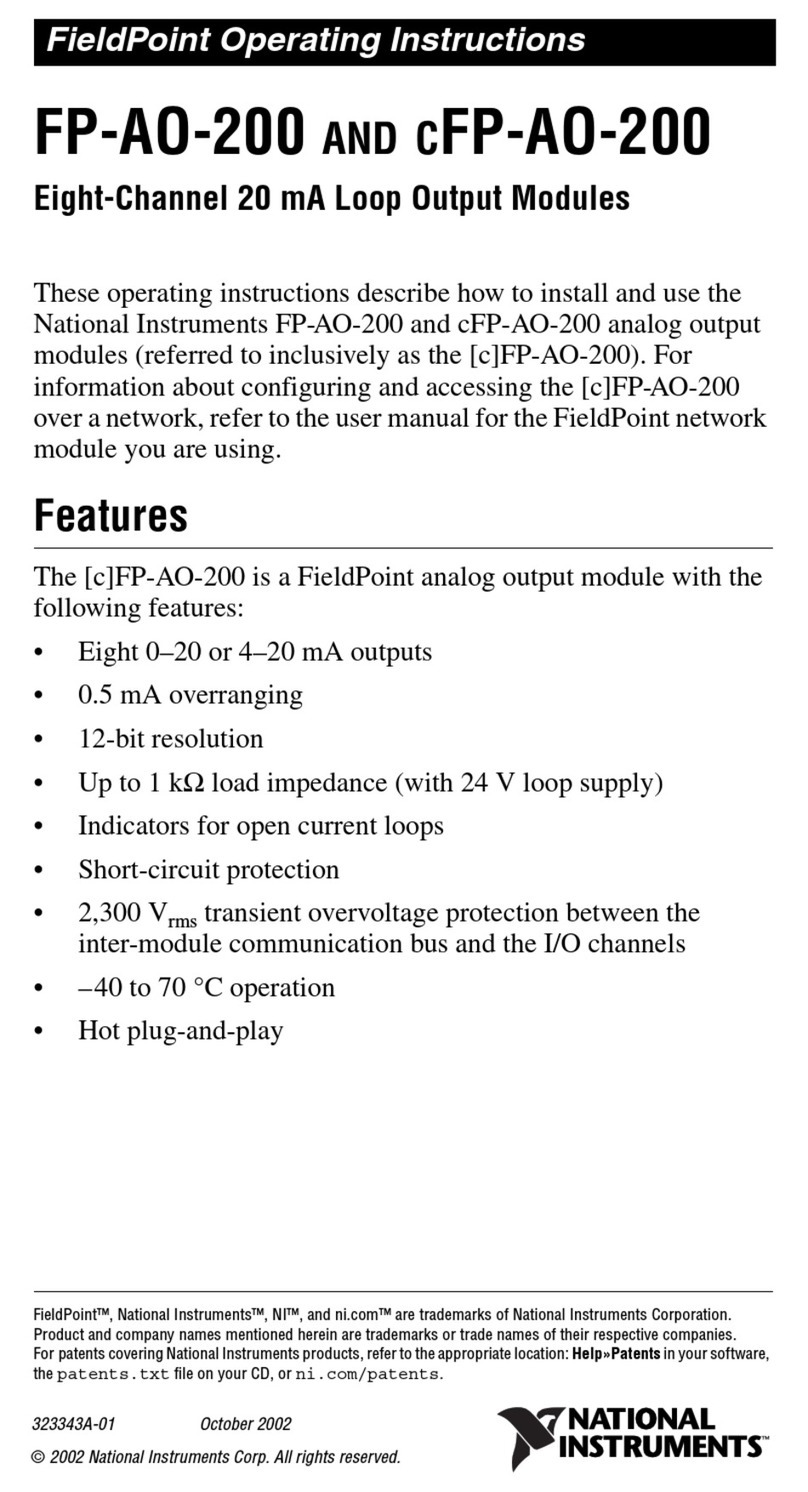
National Instruments
National Instruments FIeldPoint FP-AO-200 operating instructions
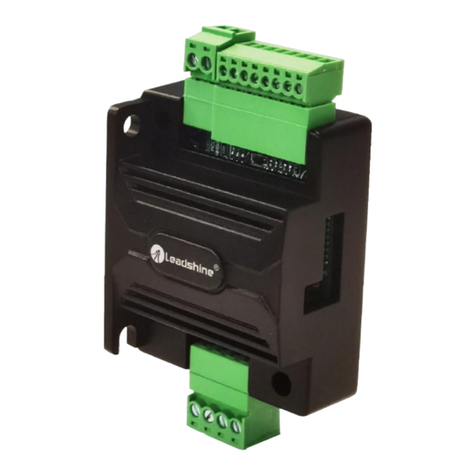
Leadshine Technology
Leadshine Technology EM532MINI user manual
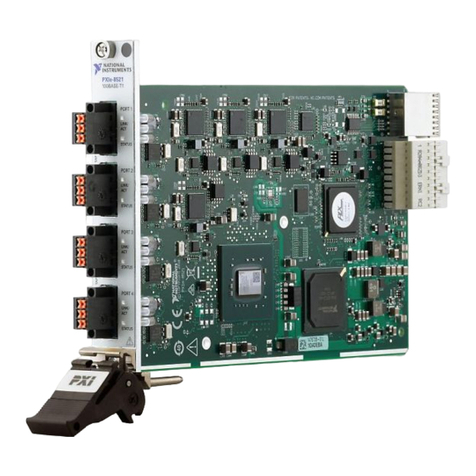
National Instruments
National Instruments PXIe-8521 user manual
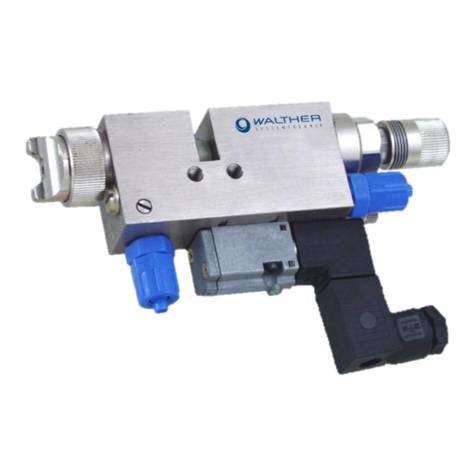
Walther
Walther SMS-02 Assembly instructions
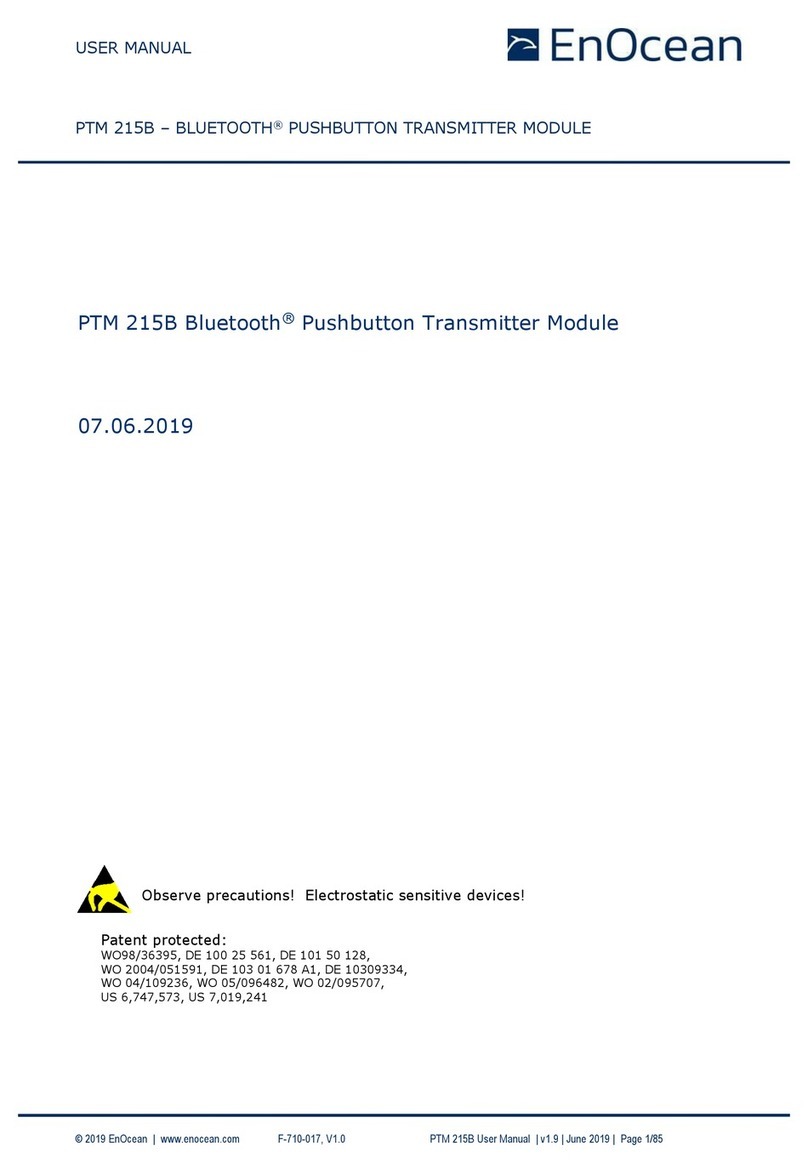
EnOcean
EnOcean PTM 215B user manual
